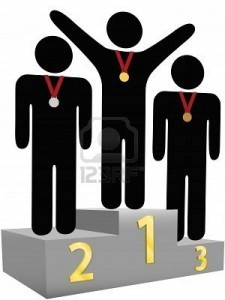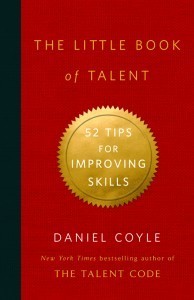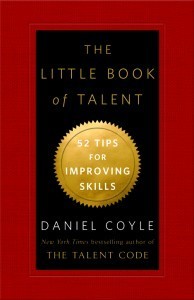Daniel Coyle's Blog, page 18
February 15, 2012
How to Spot High-Quality Learning? The Nose Knows.
 So here's a question: does high-quality learning — by which I mean deep, deliberate practice — create a telltale facial expression, sort of like what a poker player would call a "tell"?
So here's a question: does high-quality learning — by which I mean deep, deliberate practice — create a telltale facial expression, sort of like what a poker player would call a "tell"?
And if it does, can we use that tell as a guide?
In the book I talk about the "Clint Eastwood faces" I encountered in my reporting at the hotbeds. But lately I've been looking more deeply at those faces — the long, intense gaze, the tight mouth, the furrowed brow. One feature that seems to show up every time, whether in violin students or martial artists or algebra students: flared nostrils.
I know it sounds kind of strange. But maybe there's a deeper biological mechanism going on here. Daniel Kahneman, in his great book Thinking, Fast and Slow, points out that our eyes dilate noticeably and uncontrollably when we concentrate on solving difficult problems. There's also evidence that other automatic expressions — for instance, the tongue protruding slightly from the lips — have the benefit of immobilizing speech and thus improving concentration. Flared nostrils might be part of a larger set of advantageous reflexes, part of our evolution-built "focus face" we use when we employ all our mental energy to work through tough problems.
So if the nose knows, the real question is, can this knowledge be applied?
One idea: treat the flare like a flashing neon sign that says "Good Practice Happening Here." That is, if you spot the flare, leave the practicer alone — they're already in the zone on the edge of their ability where learning happens fastest. And if you don't see it, alter the environment to create more reaching, more stretching, more failing and fixing. (Of course, this applies more in music and school than in sports, where noses tend to be moving around too fast to watch.)
The other question is, what other tells have you noticed? How do you know when a learner is "in the zone"?
February 10, 2012
The Senator Experiment
The other day I got a call out of the blue from a U.S. Senator (who'll remain anonymous here), with an interesting problem: he wanted to get better at his job. Quick background: he's in his mid-fifties, and not a career politician; he's not in danger of being defeated in an election, so he figures he's going to be in D.C. for a while. The Senator was essentially asking a strange and fascinating question: was there a way he could practice being a better senator?Here's how he described his goal:
"I want to become one of those people who "gets" big issues — who can frame them quickly and talk about them in clear, compelling ways. I want to be one of those senators who might only say a few words, but to whom people listen because their words cut through the clutter and capture the essence of an issue."
At first, I wasn't sure how to respond. The question seemed kinda crazy. Then we talked some more. It gradually became clear that the people who do well in this area essentially possess 3 distinct skills: 1) recognize a pattern in the landscape; 2) choose a strategy; 3) communicate that strategy to others.
We're talking, of course, about soft skills. This is not like learning to play an E-major chord or shoot a free throw (see previous post) — it's not about repeating with precision. It's more like learning to be a jazz singer, or salesperson, or an improv comic — building a fast, fluent brain capable of choosing exactly the right sequence, at speed, out of thousands of possibilities. The question the Senator is asking is the same one most of us face: what's the best way to practice soft skills? We kicked around some ideas and here's what we came up with:
1) To improve pattern recognition and choice, practice like a soccer player: consider creating "game films." Pick a recent Big Issue — for example, the financial crisis — and do an analysis of how each of the key figures behaved. Walk through the events in slo-mo; recreate their decision patterns, and learn from them. Figure out how you would want to behave in that kind of situation.
2) To improve the ability to distill issues to their essence, practice like a comedy writer: start generating material, test it out, keep what works. Political communication is like any other communication; it's about distilling and framing — figuring out just the right combination of images and words to tell your story. One good tool is Twitter: the discipline of the 140-character limit enforces the principle: it's easy to be complex — the true challenge is to get good at taking immensely complex issues and making them simple, compelling and accessible.
3) Set aside some daily time and space for practice, and start keeping a journal to record ideas, results, and to make plans.
I've no idea how this is going to go, but it feels like a potentially interesting experiment. The Senator said he'll keep me posted as to how things are going. So feel free to offer any other suggestions, and post them below. Who knows? If this takes off, he might have to call you "coach"!
February 6, 2012
The 50-Yr-Old Basketball Hacker-Genius
I love this story (click to watch the above video). It's about Bob Fisher of Centralia, KS (pop: several), who decided at age 50 to become the best free-throw shooter on the planet. And then he went out and simply did it. It's worth a look, especially to see the homemade contraptions he uses to build his remarkable skill (I also like that he mentions a certain book at the 2:45 mark). There are lots of useful takeaways here, but what I like best is Fisher's mindset. He's active. He doesn't rely on any one source of wisdom; instead, he reads everything he can get his hands on, tests it ruthlessly, keeps what works. His mindset is not one you typically find in an athlete or musician (who often have passive, obedient, "whatever you say, coach" attitudes). Fisher's mindset is like one you'd find in a hacker: searching, resourceful, always willing to invent and re-invent. He's living proof that talent isn't about obedience to authority — it's about being entrepreneurial, about taking charge, seeking out good information, and hacking until you get where you want to go. As Fisher so beautifully puts it, "Anybody could do what I do, if they know what I know."
February 1, 2012
Everybody's Doing the Flip
 So there's a Big Exciting Idea that's been whizzing around the educational oxygen recently. It's called "flipping the classroom." Bill Gates is a fan; so is Nobel Prize winner Carl Wieman, an advisor to President Obama.
So there's a Big Exciting Idea that's been whizzing around the educational oxygen recently. It's called "flipping the classroom." Bill Gates is a fan; so is Nobel Prize winner Carl Wieman, an advisor to President Obama.
Here's how it works: In regular classrooms the teacher stands at the front of the room and explains, the kids listen and absorb. Then they go home and do homework — the problem sets, the paper-writing, etc.
In a flipped classroom, the situation is reversed. First, the learners absorb the lecture at home, often via a video. Classroom time is devoted to doing the homework — grappling with the material, solving problems. Instead of being a sage on the stage, the teacher is a guide on the side, roving like a personal coach, spotting problems, giving individualized attention and guidance. Class time is about active construction, productive struggle and exploration.
Proponents of flipping make the point that video is a more efficient way to deliver lectures, because, unlike teachers, they can be rewound and watched until they're understood. Doing homework in class works better because teachers can help students struggle through problems they might otherwise abandon, if alone at home.
The interesting thing about flipped classrooms isn't just that they seem to work, especially for hard skills like math and science. It's that the concept is flexible enough to be applied to other situations. Such as:
In sports — why not flip the locker room? Coaches could deliver theories, strategies, game plans, and fundamentals via video, and spend practice time actually working on the skills.
In music — why not flip the music stand? Teachers could deliver music theory over video, and spend the practice time putting it to use.
In the workplace — why not flip training session? Instead of listening to lectures, time could be spent practicing real-life on-the-job skills.
I like flipping because it's a nice way to highlight a home truth: sitting still and listening to someone talk is a demanding and inefficient way to learn. Learning is ultimately about doing — about struggling and reaching, often with the guidance of a good coach — and the highest goal of a teacher is to design a space that makes that happen.
In other words, teachers aren't really teachers — they are designers. As Einstein put it, "I never teach my students; I only attempt to provide the conditions in which they learn."
So the next question is, what can you flip in your world?
January 24, 2012
How Great Coaches Think
 One of the most persistent myths about great coaches — who are, of course, interchangeable with great teachers and great leaders — is that their primary job is to come up with Big Ideas. You know, those creative, last-minute, improvised bursts of genius that change everything: the revolutionary strategy, the brilliant 11th-hour gambit, the heart-lifting pregame speech. This myth, born in Hollywood, is built on the governing idea of the coach/teacher/leader as visionary artist — a special one who sees something no one else can see. In other words, the coach as wizard.
One of the most persistent myths about great coaches — who are, of course, interchangeable with great teachers and great leaders — is that their primary job is to come up with Big Ideas. You know, those creative, last-minute, improvised bursts of genius that change everything: the revolutionary strategy, the brilliant 11th-hour gambit, the heart-lifting pregame speech. This myth, born in Hollywood, is built on the governing idea of the coach/teacher/leader as visionary artist — a special one who sees something no one else can see. In other words, the coach as wizard.
It's a tempting view — because from a distance, it seems to be true enough. The problem is, when you look closely at great coaches/teachers, they're doing precisely the opposite. They're not thinking like wizards. They're thinking like construction workers.
For a revealing glimpse into this mindset, check out the Belichick Breakdowns, a weekly video by the man currently regarded as the greatest living wizard, Bill Belichick of the New England Patriots, who are headed to their fifth Super Bowl in 11 years.
In the series, Belichick analyzes half a dozen or so key plays from the previous game. The remarkable thing is what he considers to be key plays — and what he doesn't. As Seth Stevenson points out here, the coach doesn't focus on the big moments we notice — he skips over all the amazing athletic moves, the key turnovers, and pretty much anything that you might remember from the game. Instead, he focuses exclusively and obsessively on Little Things — the perfectly executed block that turned a 3-yard run into a 5-yard run. The way a defensive player sealed off an end that led to an incompletion. He focuses, time after time, on small moments.
This is not an accident — this is, in fact, his construction-worker mindset in action. This mindset focuses on three qualities, which can be approached as questions. Think of these questions as the filter in a great coach's mind, governing his attention and action.
1) Is it Replicable? Is this a one-off fluke, or is it an action that can be applied in a variety of situations? Blocking technique matters on every single play. If Belichick were a guitar teacher, he wouldn't care about that kick-ass solo — instead, he'd obsess about thumb position and finger angle, the stuff that matters on every single chord you play.
2) Is it Controllable? Is this something that has to do with effort, awareness and planning? If you watch the breakdowns, you'll see how he makes heroes of players who pay attention, who anticipate, who get to the right spot at the right time. If Belichick were a high-school English teacher teaching Huckleberry Finn, he'd make heroes of the students who are first to spot the themes and connections in the text, because that's about awareness and effort.
3) Is it Connective? Is it related to a successful outcome? Belichick understands that every big play is built on a scaffold of solid technique. So he focuses, like any good construction worker would, on the foundational things that made success possible. Each of those small moves (the perfectly executed block) is in fact vital, because without it all the good luck (the big pass play) never happens. If Belichick were a sales consultant, he'd focus on the first ten seconds of the sales call — because without a warm emotional connection, the sale would never happen.
It's no accident that Belichick's Super Bowl counterpart is Tom Coughlin of the NY Giants, who's cut of a similar construction-worker cloth. If you watched Sunday's game you saw the Giants win with an overtime field goal in wet conditions. It turns out that the Giants practiced all week snapping and kicking wet balls — they soaked them in a water tank. It probably seemed silly and small and obsessive at the time. But in fact, they were building toward a win.
PS — For another view into this mindset from a classroom POV, check out Doug Lemov's Teach Like a Champion. It's great.
January 18, 2012
The 3 Levels of Effective Practice
 I'm always on the lookout for new ways to understand highly effective practice, and recently came across a keeper from Vern Gambetta, the well-known coach and athletic consultant. It's called "winning the workout." (Here's a short video describing it.)
I'm always on the lookout for new ways to understand highly effective practice, and recently came across a keeper from Vern Gambetta, the well-known coach and athletic consultant. It's called "winning the workout." (Here's a short video describing it.)
At its core is the idea that there are three essential ways of approaching a practice session.
Level 1) You show up. You do the job exactly as you're told to do it; nothing more, nothing less. You get a little better.
Level 2) You show up. You do the job, and you target certain tasks that'll help you toward your goal. You work the workout, push yourself, think about technique. You get a lot better.
Level 3) You show up, having thought about how today's session fits into the larger goal. You work very hard, pushing yourself into the discomfort zone over and over, with full commitment. Later, you reflect/analyze/critique your performance with a cool, objective eye. You get a LOT better, creating what Gambetta calls "the quantum leap."
Think of the three levels as bronze, silver, and gold. Level 3 is winning the workout.
Traditionally, when we talk about effective practice, we use the idea of focus — the amount of attention a person puts into their actions. After all, that's the one word parents and coaches often yell from the sidelines — "Focus!" (And it usually works about as well as you'd expect.)
One reason I like Gambetta's concept is that it takes us beyond the primitive idea of focus and into the more targeted idea of investment — sensing and measuring the total amount of time and energy put into the process of getting better. I also like it because it embraces the semi-revolutionary idea that some of the most vital work happens away from the practice space, in the time we use to reflect, strategize, plan, and figure out honest answers to those two simple but immensely difficult questions we face every day: where are we right now, really? Where we want to be tomorrow?
The more immediate question is, how do you increase investment and win the workout? Here are two ideas.
1) Notebooks. Writing stuff down is a good way to increase planning, reflection, and understanding; it lets us think our way past obstacles and see ourselves clearly. Check out writingathletes.com for some good ideas and tools.
2) Make a habit of connecting every session, every drill, to the longterm goal. One way to think about this is to think like a movie camera, zooming in and out. Zoom in on the task, then zoom out to show where it fits in the bigger picture.
(Big thanks to sharp-eyed reader Gerald Murray for alerting me to Gambetta's work.)
January 13, 2012
Choices, Choices
A late Christmas present just arrived! I'm psyched because I just got the first cover design for my new book, The Little Book of Talent, that'll come out in September. Actually, two designs.
The question is, which to pick? That's where you excellent people come in.
FYI, the book will be pretty little — it'll measure 7 inches by 4.5 inches. It'll be hardback, and it'll have no jacket — just plain cloth. We're aiming for a classic/timeless feeling, but we don't want it to feel old-fashioned or fusty. In other words, not your grandpa's little book.
First, we have choice A:
Then, option B:
(In our family voting, there was a clear winner. I'll tell you which in a little while, so as not to skew the voting process.)
January 11, 2012
Is This Great, Or is it Creepy?
Okay, I've been watching this video of this five-year-old kid, and I just can't decide: is it amazing, or is it creepy?
(I'll take a polite break while you watch.)
On one hand, the kid is totally amazing. So much control, discipline, balance, and ferocious focus. So much raw effort, so many hours spent practicing. If this kid were playing music or writing poetry, we wouldn't find it creepy at all. Is he really any different from a young Mozart, or a Williams sister?
On the other hand, it is sort of creepy to see this level of expertise in a kid this young, isn't it? It seems out of balance with our ideas about childhood. Is it mentally or physically healthy to be on a regimen like this? Who is really driving the bus here, the kid or the whispering parent? Is this a train wreck in the making — another overtrained prodigy destined for burnout and sadness?
This kid embodies the thorny question we all deal with. How much effort do we put into building narrow expertise, and how much into the broader social muscles? In other words, how much should we specialize to build the skills that make us unique, and how much should we spend time developing the muscles we need to make and maintain relationships, control emotions, and learn to communicate with others?
What do you think?
December 22, 2011
The Uses of Enchantment
 I recently bumped into a wonderful book called The Game, by Ken Dryden, a Hall of Fame NHL goalie and uncommonly thoughtful writer. On the surface, it's about sports, but underneath it's about learning — specifically, the special moments when it begins to accelerate. At one point, Dryden is reflecting on the skills of the great players he's met.
I recently bumped into a wonderful book called The Game, by Ken Dryden, a Hall of Fame NHL goalie and uncommonly thoughtful writer. On the surface, it's about sports, but underneath it's about learning — specifically, the special moments when it begins to accelerate. At one point, Dryden is reflecting on the skills of the great players he's met.
It is in free time that the special player develops, not in the competitive expedience of games, in hour-long practices once a week, in mechanical devotion to packaged, processed, coaching-manual, hockey-school skills. For while skills are necessary, setting out as they do the limits of anything, more is needed to transform those skills into something special. Mostly it is time unencumbered, unhurried, time of a different quality, more time, time to find wrong answers, to find a few that are right; time to find your own right answers; time for skills to be practiced, to set higher limits, to settle and assimilate and become fully and completely yours, to organize and combine with other skills comfortably and easily in some uniquely personal way, then to be set loose, trusted, to find new instinctive directions to take, to create.
I love that phrase: time unencumbered, unhurried, of a different quality. That's a type of time that seems in tragically short supply these days. I'm not going to add to the chorus of people decrying our hurried, overscheduled lives, but I will point out that the main barrier to achieving more of this unencumbered time is the mistaken sense of emptiness; the anxiety that we're missing out on some important activity, the nagging worry that nothing's happening. In truth, everything's happening.
Two of our kids go to a Montessori school, whose founder coined a terrific term: "enchantment with materials." This refers to the relationship between a learner and the physical elements of the environment – the blocks, the violin, the tennis ball, the pencil and paper. Those things – those simple, everyday objects – are seen as magical, worthy of reverence and care. (Think about what you're good at, and your relationship with those materials.) The enchantment powers the process – it's the fuel tank, that keeps someone coming back, experimenting, playing, doing what Dryden so eloquently describes – creating their skill.
I think these two ideas work together — unencumbered time and enchantment. They're the yin and yang of learning: unencumbered time allows the enchantment to happen; the enchantment fills the time with engagement and learning.
So with that in mind, I'd like to wish you all an enchanted, unencumbered holiday. Thanks for reading and commenting this year; I really appreciate it, and you. Merry Christmas, Dan
December 14, 2011
How to Fail Smarter: The Goldilocks Rule
I've been traveling lately in the business world and in the sports/music worlds. No matter where I go, I'm hearing conversations about the importance of failure. About how struggle makes you smarter, how mistakes are useful. Failure, it seems, is sexy.
Take Silicon Valley, for instance, where working on a failed startup is often regarded as a badge of honor superior to a Ph.D. Or education reformers talking about creating spaces for "productive struggle." Or coaches extolling the importance of 10,000 hours of intensive practice, where you try, fail, and try again.
All in all, I think this is a really good thing. But here's the catch: all failure is not created equal. In other words, some types of failure are smarter than others because they create learning. Other failures are worse, because they create more failures. The question is, how do we tell smart failure from dumb failure?
One way to approach this question is to use the Goldilocks model, inspired by the work of Dr. Robert Bjork and Lev Vygotsky. As in the story, there are three zones of failure: too soft, too hard, and just right.
Zone 1: The Comfort Zone: Here, you're able to hit your target more than 90 percent of the time. You're in control; relaxed, confident. You're not reaching past your current abilities, but operating firmly within them. You're like an advanced skier on a beginner run, carving turns with ease and grace.
Zone 2: The Thrash Zone: Here, you're failing more than half the time. When you succeed, it's mostly because you're getting lucky. You're behaving like a beginning skier fighting his way down a steep expert run: occasionally you might make a good turn, but more often you're just trying to get to the bottom in one piece.
Zone 3: The Sweet Spot: Here, you're in between Comfort and Thrashing. You're putting forth maximal effort and you're succeeding between 60 percent and 80 percent of the time. You're failing — sometimes spectacularly — and you're paying attention, and learning from each screwup.
As with Goldilocks, this goal of this rule is to help us make the right choice between different options. To put this idea to work, here's a quiz:
Should a student cram for a history test by (A) reading a chapter over and over five times, or (B) by reading the chapter once and then constructing an outline of the key points?
Should a business train its new sales force by (A) sending them into the field to see how they do or (B) by constructing a series of role-playing exercises led by a master coach?
Should a pianist spend her practice hour (A) playing a song perfectly, over and over, or (B) isolating the weak spots in a new song, repeating them until they're improved?
The basic rule in all cases is to choose (B), and aim for the sweet spot. Steer clear of comfort and thrashing, especially when you're starting something new. The second rule is that when in doubt, keep things small and simple. The smaller and simpler the task, the easier it is to locate your sweet spot.






